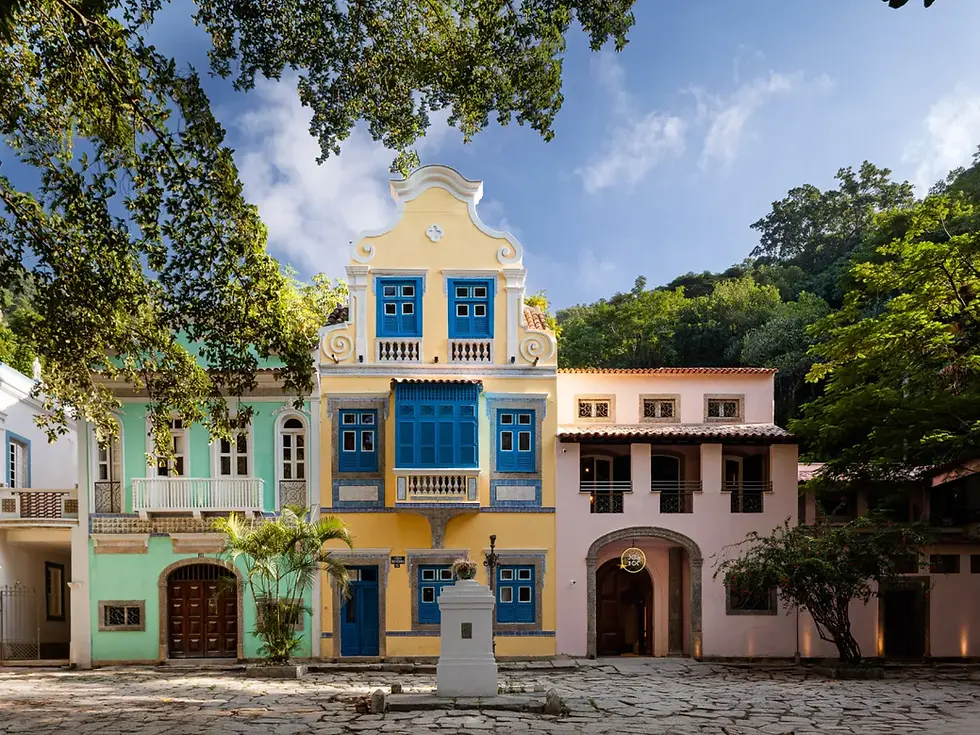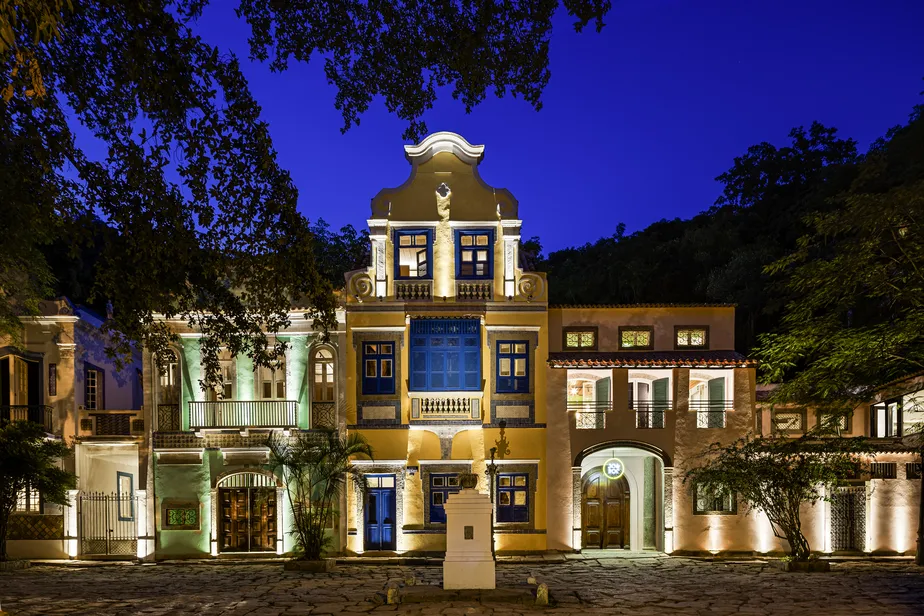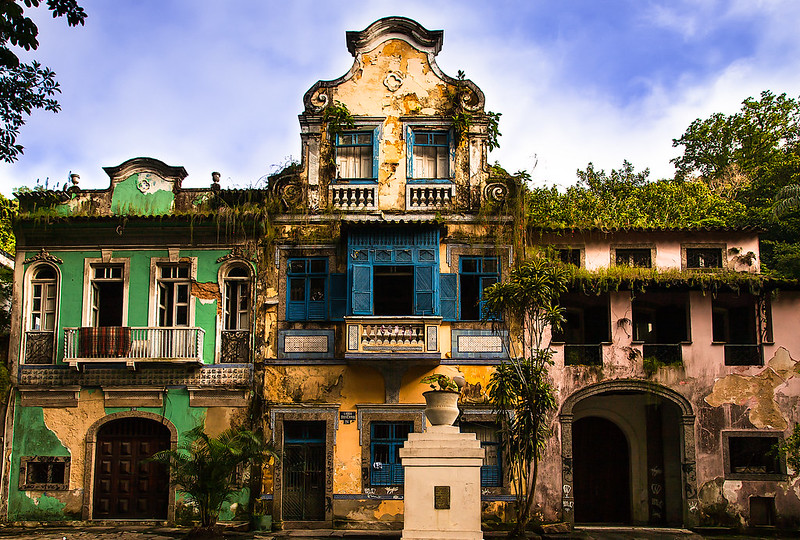Apothecary's Square
- Frederico Aversa Masson
- Jul 15
- 3 min read
Updated: Jul 16

The Apothecary's Square (Largo do Boticário in Portuguese) is a historic square in the Cosme Velho neighborhood, in the South Zone of Rio de Janeiro. Largely unknown to both tourists and locals, the square can be accessed through the Apothecary's Alley (Beco do Boticário in Portuguese). With its Colonial-style buildings surrounded by the lush Atlantic Rainforest, is a remnant of 19th- and early 20th-century Rio. The square was named after Sargeant Joaquim Luiz da Silva Souto, a successful 19th-century apothecary (an early form of a pharmaceutist) who was the land's first owner. Souto owned a store in Rio's Center Region (on Rua Direita, the city's main commercial street in the early 19th century), which had some high-profile customers, including members of the Brazilian Imperial Family and its Court. Following high profits, Souto purchased lands in Cosme Velho (which would become the Apothecary's Square) in 1831. Over the decades that followed, more people settled in the square and its remarkable Colonial-style mansions were erected, while it retained the name Apothecary's Square as a tribute to its original inhabitant. During the 1850s, the square became an effervescent gathering spot for artists, members of the Imperial Court, intellectuals, and even Emperor Dom Pedro II himself, as opulent parties and balls were held there. However, by the final decades of the 19th century, the Apothecary's Square had fallen into decline, as its inhabitants moved away and its once-grand Colonial-style mansions were left abandoned and deteriorating. By the turn of the century, mansions in Ecletic style were built in Apothecary's Square by new owners in the region, while some of older Colonial-style buildings were refurbished in the Ecletic-style. As in many parts of Rio's Center Region, the juxtaposition of 19th-century Colonial-style architecture and early 20th-century Ecletic style created a striking and memorable contrast in the square. It was in the 1920s, however, that the square acquired the remarkable appearance it retains today. Edmundo Bittencourt, founder of Correio da Manhã—one of the most reputable newspapers of the period—, purchased land in the area and began building and renovating houses in Neocolonial style—which evoked characteristics of traditional Portuguese Colonial architecture while incorporating Modernist features.
Following Edmundo's death, the renovation process continued through the 1930s and 1940s, led by Correio da Manhã's heir, Paulo Bittencourt, along with his wife, Sylvia Bittencourt, and diplomat Rodolfo da Siqueira. Renowned Modernist architects Lucio Costa and Gregori Warchavchik also contributed, refurbishing some of the houses in the Neocolonial style.
Also during the 1940s, Walt Disney visited Paulo Bittencourt's mansion in Apothecary's Square while in Rio on a diplomatic mission aimed at strengthening U.S.-Brazil relation amidst World War II. As a result of this trip, Disney created Jose Carioca—a parrot from Rio who befriends Donald Duck and embodies a myriad of elements from the Brazilian and Rio de Janeiro's culture.
Walt Disney is not the only connection Apothecary's Square has to cinema. In the 1970s, a scene from Moonraker (1979) was shot in the square, as Rio de Janeiro was one of the locations featured in the movie.
In 1987, the historical and cultural significance of Apothecary's Square was officially recognized by Rio de Janeiro's State Institute for Cultural Heritage (INEPAC), which has protected the site ever since. However, despite this preservation status, the square suffered significant deterioration and neglect throughout the 1990s and 2000s.
In 2018, after years of abandonment, all the properties at Apothecary's Square were acquired by French hospitality company Accor. Due to its protected status under INEPAC, the square was initially ineligible for major renovations or functional repurposing, but these restrictions were loosened by Rio's government to allow Accor to restore and revitalize the region. Ever since July 2022, Accor's JO&JOE Rio de Janeiro hotel has been operating in the now revitalized and increasingly touristic Apothecary's Square.
Sources & References
Accor. (August, 2024). Largo do Boticário: história, onde fica e o que fazer. Retrieved from https://all.accor.com/a/pt-br/limitless/thematics/city-breaks/conheca-o-largo-do-boticario-no-rio-de-janeiro.html
Rio Cidade Maravilhosa. (n.d.). Largo do Boticário. Retrieved from https://www.riocidademaravilhosa.com.br/oquefazer/historico/largodoboticario/
Diário do Rio. (2023, March 8). Vivendo nova era, Largo do Boticário se torna o 'queridinho' para realização de eventos no Rio. Retrieved from https://diariodorio.com/vivendo-nova-era-largo-do-boticario-se-torna-o-queridinho-para-realizacao-de-eventos-no-rio/
Tourb. (n.d.). Sobre Largo do Boticário. Retrieved from https://tourb.com.br/rio-de-janeiro/lugares/parques-e-pracas/largo-do-boticario/
Images Credits
Image 1: Jo&Joe/Divulgação. Retrieved from https://viagemeturismo.abril.com.br/brasil/largo-do-boticario-e-revitalizado-e-transformado-em-hotel-no-rio/#google_vignette
Image 2: Dhani Borges | O Globo. Retrieved from https://oglobo.globo.com/ela/viagem/noticia/2022/07/depois-de-anos-de-abandono-largo-do-boticario-e-revitalizado-e-recebe-hotel-jovem-e-descontraido.ghtml
Image 3: Retrieved from https://foradatoca.com/brasil/rio-de-janeiro/o-charmoso-largo-do-boticario/
Image 4: Adriano Ferreira | Flickr. Retrieved from https://caosplanejado.com/largo-do-boticario-o-triste-destino-de-um-tombamento/








Comments